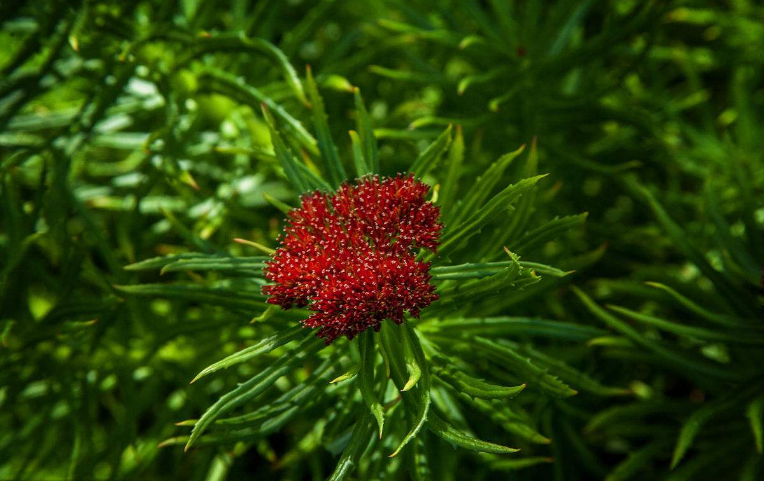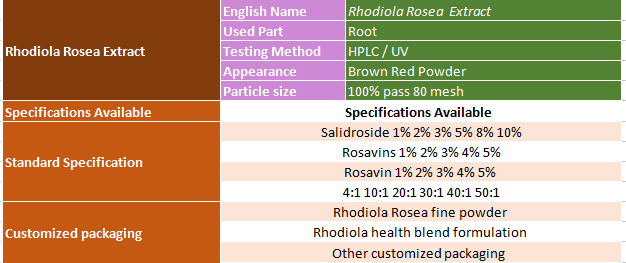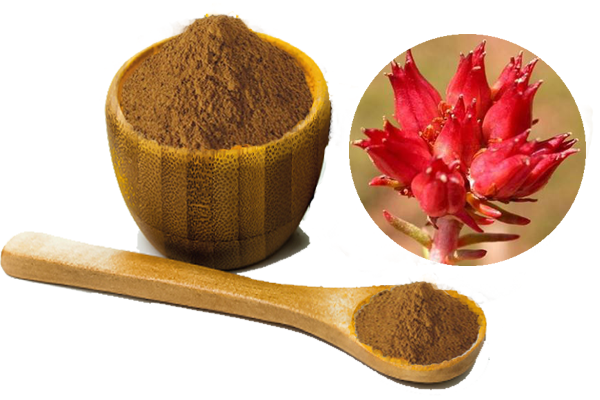
Rhodiola Rosea Extract 1% ~10% Salidroside / Rosavins /Rosavin by HPCL offered by MIGU-– a 17 years experienced cGMP manufacturer with warehosues in NJ & CA, USA.
Latin Name: Rhodiola rosea L.
Material Original: Tibet ,China
Extracted Part:Root
Supported Purity: Rhodiola Rosea Extract 1% ~5% Salidroside / Rosavins /Rosavin
The History of Rhodiola Rosea Extract
Rhodiola rosea L.,also known as “golden root” or “roseroot” belongs to the plant family Crassulaceae.For
centuries, R. rosea has been used in the traditional medicine of Russia, Scandinavia, and other countries.
Between 1725 and 1960, various medicinal applications of R. rosea appeared in the scientific literature of
Sweden, Norway, France, Germany, the Soviet Union, and Iceland.2,4-12 Since 1960, more than 180
pharmacological, phytochemical, and clinical studies have been published. Although R.rosea has been
extensively studied as an adaptogen with various health-promoting effects, its properties remain largely
unknown in the West. In part this may be due to the fact that the bulk of research has been published
in Slavic and Scandinavian languages. This review provides an introduction to some of the traditional
uses of R.rosea,its phytochemistry, scientific studies exploring its diverse physiological effects, and its
current and future medical applications.

Rhodiola Rosea Extract.png
How does the Rhodiola Rosea Extract Actions in pharmacological
Traditional folk medicine used R. rosea to increase physical endurance, work productivity,longevity,
resistance to high altitude sickness, and to treat fatigue, depression, anemia, impotence, gastrointestinal
ailments, infections, and nervous system disorders. In mountain villages of Siberia,a bouquet of roots is
still given to couples prior to marriage to enhance fertility and assure the birth of healthy children. In Middle
Asia, R.rosea tea was the most effective treatment for cold and flu during severe Asian winters.Mongolian
doctors prescribed it for tuberculosis and cancer.For centuries, only family members knew where to harvest
the wild “golden roots”and the methods of extraction. Siberians secretly transported the herb down ancient
trails to the Caucasian Mountains where it was traded for Georgian wines,fruits, garlic,and honey.Chinese
emperors sent expeditions to Siberia to bring back the “golden root” for medicinal preparations.
Linnaeus wrote ofR.rosea as an astringent and for the treatment of hernia,leucorrhoea(vaginal discharge)
hysteria, and headache.In 1755 R.rosea was included in the first Swedish Pharmacopoeia. Vikings used the
herb to enhance their physical strength and endurance.German researchers described the benefits of
R. rosea for pain, headache scurvy, hemorrhoids, as a stimulant, and as an anti-inflammatory.
In1961,G.V.Krylov, Russian botanist and taxonomist in the Department of Botany at the Novosibirsk Branch
of the Russian Academy of Sciences,led an expedition to the cedar taiga in the Altai Mountain of southern
Siberia where he located and identified the “golden root” as Rhodiola rosea.Extracts of the R. rosea root
were found to contain powerful adaptogens. Research revealed that it protected animals and humans from
mental and physical stress toxins, cold. The quest for new medicines to treat disease such as cancer and
radiation sickness, and to enhance physical and mental performance,led to the discovery of a group of
phenylpropanoids that are specific to R.rosea. (See Phytochemistry section below.)

rhodiola rosea extract.png
Phytochemistry of Rhodiola rosea Extract
The investigation of the phytochemistry of R. rosea root has revealed the presence of six distinct groups of
chemical compounds:
- Phenylpropanoids: rosavin, rosin, rosarin (specific to R. rosea;
- Phenylethanol derivatives: salidroside (rhodioloside), tyrosol;
- Flavanoids: rodiolin, rodionin, rodiosin, acetylrodalgin, tricin;
- Monoterpernes: rosiridol, rosaridin;
- Triterpenes: daucosterol, beta-sitosterol;
- Phenolic acids: chlorogenic and hydroxycinnamic, gallic acids.
The standardization of R. rosea root extracts has gone through two distinct phases. Initially, in the
1970s,the compound responsible for its unique pharmacological properties was believed to be
salidroside(rhodioloside).Therefore,the first generation of Rrosea tincture/extract approved by the Russian
Pharmacopoeia Committee was standardized to a minimum of 0.8 percent salidroside content.
In the late 1980s, demand for R.rosea-based phytomedicines dramatically increased.The wild-crafted raw
material was overharvested,resulting in steady decline in the quality and effectiveness of”Rhodiola“preparations.
Scientific investigation revealed other species of genus Rhodiola (which also contained salidroside) were
being substituted for Rrosea.While some of these mixed batche were highly variable in quality,other had no
pharmacological effect Logically, the suspicion arose that the salidroside standard was inadequate. Based
on comparative analysis,the obvious hypothesis was that the original high potency product contained other
active compounds specific to R rosea that had not yet been identified.
Pharmacological and Clinical Studies for Rhodiola Rosea Extract
The traditional use of R. rosea as a tonic in Siberian and Russian medicine stimulated extensive research
leading to identification of R. rosea as an adaptogen — a substance that nonspecifically increases the
resistance of an organism and does not disturb normal biological parameters. Studies in cell cultures,
animals, and humans have revealed antifatigue,antistress,antihypoxic(protection against damaging effect
of oxygen deprivation),anticancer, antioxidant, immune enhancing and sexual stimulating effects. Since
the Russian and Bulgarian literature is so extensive, this discussion will highlight seminal studies and
major reviews. The authors were fortunate to gain access to original reviews, articles, and doctoral theses.
This overview relies heavily on monographs and peer-reviewed publications. The research data
contained in these documents are helpful for understanding recent human studies in normal and
pathological conditions.
The benefit of Rhodiola Rosea Extract in Physical Work Capacity
1)Adaptogenic effects–Plant adaptogens, such as those from R. rosea ,have been suggested for
improving mental and physical performance through stimulatory effects on various physiological
systems.Rrosea ‘s use in traditional Ayurvedic medicine for adaptogenic properties has been examined.
Animal data-R.rosea increased the survival of freshwater snail eggs against induced stressors,including
heat shock and oxidative and heavy metal stress.Injections of the plant extract administered to rat
prevented stressinduced elevations of beta-endorphins, adrenocorticotropic hormone, cortisol, insulin,
thyroxin, and triiodothyronine. Similarly,R. rosea given to rats increased swimming time up to 159%,with
improvement continuing throughout the supplementation period.
Clinical data-Positive findings were reported in a clinical trial conducted among 56physicians experiencing
fatigue during night duty and among students during stressful examination periods. Improved sleep
patterns and overall quality of sleep have been described with the use of R. rosea . Results of older
trials evaluating the effect of R. rosea on physical performance suggest a positive effect; however, most
recent trials report no effect on time to exhaustion,cardiovascular outcomes, tissue hypoxia,or rate of
adenosine triphosphate turnover for R. rosea extracts.
2)Cancer–The usefulness of R.rosea as an antioxidant and anticarcinogenic agent has been suggested
in earlier in vitro studies by a number of researchers. Several anti-oxidant compounds have been
identified in the plant, including p-tyrosol,organic acids,and flavonoid.A mechanism of action has been
described that includes induction of apoptosis and necrosis.
Animal data–The same researchers describe experiments in animals with induced cancers. R. rosea
potentiated antitumor and antimetastatic effect in mice with lung carcinoma,inhibited tumor dissemination,
inhibited growth rate of Ehrlich tumor and Pliss lymphosarcoma, and protected tissues from cyclophosphamide
toxicity.Another in vitro experiment showed efficacy against prostate cancer cells in rats.
Clinical data–R. rosea extract administration improved certain parameters in superficial bladder carcinoma
in a small (N = 12) study.
3)Depression–Central nervous system (CNS) activity of R. rosea has been reported. Earlier studies found
that low to medium doses of the plant had stimulatory effects while larger doses had sedative effects. In
lower doses, R. rosea stimulated norepinephrine, dopamine, serotonin, and nicotinic cholinergic systems in
the CNS. R.rosea also appears to increase the permeability of the blood-brain barrier to precursors of
dopamine and serotonin and also appears to improve cerebral circulation.
Clinical data–A systematic review of 4 clinical trials of R. rosea in psychiatric disorders found sufficient
positive results to warrant further research. The author suggests that a stimulating adaptogenic effect is
responsible for antidepressant activity.A double-blind,randomized clinical trial of R. rosea conducted over 6
weeks in 89 patients with mild to moderate depression confirmed potential antidepressive effect compared
with placebo,as measured on the Hamilton Depression Rating Scale as well as the Beck Depression Inventory.
The method of action remains unclear, but is thought to be linked to mood stabilization and energy
restoration. Earlier trials of varying methodology have produced conflicting results.
4)Muscle Recovery-Rhodiola rosea has been shown to shorten recovery time after prolonged workout,to
increase attention span, memory, strength, and anti-toxic action. Rhodiola rosea extract increases the level
of enzymes,RNA,and proteins important to muscle recovery after exhaustive exercise.It also stimulates
muscle energy status; glycogen synthesis in muscles and liver; muscle protein synthesis and anabolic activity.
Other Benefits for Rhodiola Rosea Extract
Many other benefits from the use of Rhodiola has been found including its ability to improve hearing,to regulate
blood sugar levels for diabetics and protect the liver from environmental toxins.It has been shown to activate
the lipolytic processes(fat breakdown)and mobilise lipid from adipose tissue to the natural fat burning system of
your body for weight reduction.It can also clinically enhance thyroid function without causing hyperthyroidism,
enhance thymus gland function and protect or delay involution that occurs with ageing.It can also improve your
adrenal gland reserves without causing hypertrophy.Throughout the years it has shown to substantially improve
erectile dysfunction and/or premature ejaculation in men and normalises their prostatic fluid.
Toxicity, Side Effects, and Contraindication for Rhodiola Rosea Extract
R.rosea has a very low level of toxicity.In rat toxicity studies,the LD50(lethal dose at which 50 percent of animals
die)was calculated to be 28.6 ml/kg,approximately 3,360 mg/kg.25 The equivalent dosage in a 70kg man would be
about 235 gm or 235,000 mg.Since the usual clinical doses are 200-600 mg/day,there is a huge margin of safety.87
Overall,R.rosea has very few side effects.Most users find that it improves their mood,energy level,and mental
clarity.Some individuals,particularly those who tend to be anxious,may feel overly activated,jittery,or agitated.
If this occurs,then a smaller dose with very gradual increases may be needed.R.rosea should be taken early in
the day because it can interfere with sleep or cause vivid dreams(not nightmares)during the first few weeks.It is
contraindicated in excited states.Because R.rosea has an activating antidepressant effect,it should not be used
in individuals with bipolar disorder who are vulnerable to be coming manic when given anti-depressants or
stimulants.Until this has been further studied,the authors advise caution in patients with bipolar spectrum
disorders.The herb does not appear to interact with other medications,though it may have additive effects with
other stimulants.It is best absorbed when taken on an empty stomach 30 minutes before breakfast and lunch.As
with any herbal preparation,patients should inform their primary healthcare practitioner when taking R.Rosea.
More Scientific research and development , please check here
Reference
1. Linnaeus C. Materia Medica. Liber I. De Plantis. Stockholm, Sweden: Lars Salvius; 1749. p. 168.
2. Linnaeus C. Örtabok. Stockholm, Sweden: Almquist and Wiksell; 1725. p. 127.
3. Linnaeus C. Plants of Lapland. Uppsala, Sweden: The Royal Science Academy’s documents; 1754. p. 182-7.
4. Linnaeus C. Flora Oeconomica eller Hushålls-Nyttan af de i Swerige, Wildt wäxande Örter. Stockholm, Sweden:
Lars Salvii; 1748. p. 399.
5. Linnaeus C, Tonning H. Norwegian Rarities. Uppsala, Sweden: Johan Edman;1768. p. 3-19.
6. Sandberg F, Bohlin L. Fytoterapi: växbaserade läkemedel [Remedies based on herbs]. Stockholm, Sweden:
Hälsokostrådets förlag AB; 1993. p. 131.
7. Commission Nationale de la Pharmacopée Française. Pharmacopée Française. IX ed. Table alphabétique revisée
des drogues végétales. Paris, France: French Agence du Médicament–Direction des French Laboratoires et des
Contrôles, Unité Pharmacopée; 1974. p. II A214-101.
8. Rohloff J. Volatiles from rhizomes of Rhodiola rosea L. Phytochemistry . 2002;59(6):655-661.
9. Lee MW, Lee YA, Park HM, et al. Antioxidative phenolic compounds from the roots of Rhodiola sachalinensis A.
Bor. Pharm Res . 2000;23(5):455-458.
10.Panossian A, Wagner H. Stimulating effect of adaptogens: an overview with particular reference to their efficacy
following single dose administration. Phytother Res . 2005;19(10):819-838.
11.Rege NN, Thatte UM, Dahanuker SA. Adaptogenic properties of six rasayana herbs used in Ayurvedic medicine.
Phytother Res . 1999;13(4):275-291.
12.Boon-Niermeijer EK, van den Berg A, Wikman G, Wiegant FA. Phyto-adaptogens protect against environmental
stress-induced death of embryos from the freshwater snail Lymnaea stagnalis . Phytomedicine . 2000;7(5):389-399.
13.Lishmanov IuB, Trifonova ZhV, Tsibin AN, Maslova LV, Dement’eva LA. Plasma beta-endorphin and stress hormones
in stress and adaptation [in Russian]. Biull Eksp Biol Med . 1987;103(4):422-424.
14.Azizov AP, Seifulla RD. The effect of elton, leveton, fitoton and adapton on the work capacity of experimental
animals [in Russian]. Eksp Klin Farmakol . 1998;61(3):61-63.
15.Darbinyan V, Kteyan A, Panossian A, Gabrielian E, Wikman G, Wagner H. Rhodiola rosea in stress induced fatigue—a
double blind cross-over study of a standardized extract SHR-5 with a repeated low-dose regimen on the mental
performance of healthy physicians during night duty. Phytomedicine . 2000;7(5):365-371.









